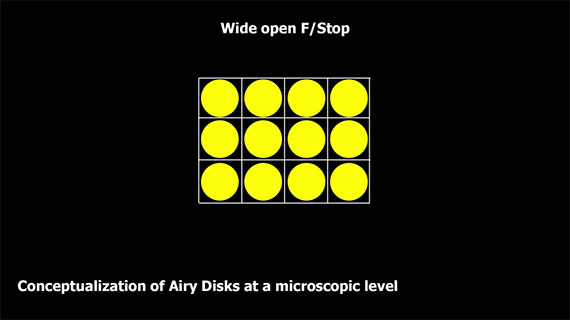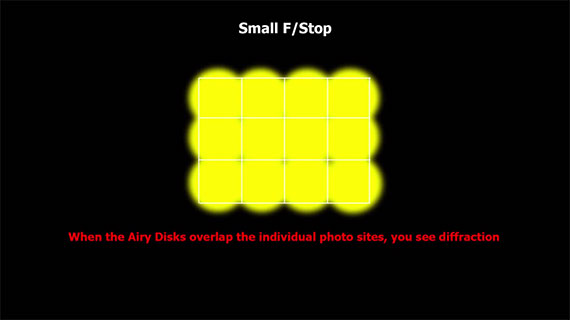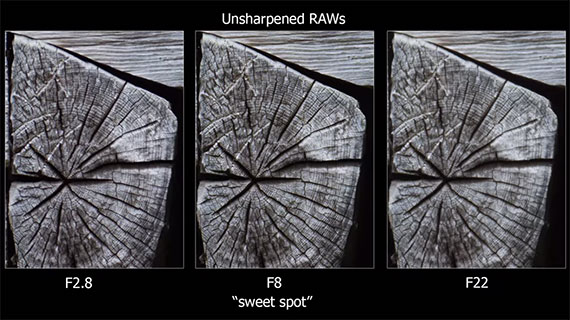FAQ: How to Avoid Small Aperture Diffraction In Photography
Feb 14, 2015 16:33:35 #
YouTube video on How to Avoid Lens Diffraction In Photography.
http://www.youtube.com/watch?v=N0FXoWdHXTk&feature=em-subs_digest
Small Aperture Diffraction (aka lens diffraction) is an anomaly with which every landscape photographer and every macro-photographer must deal. Whether you are using a top-of-the-line lens, or a very cheap lens, diffraction is undeniably going to impact your images.
So, what is Small Aperture Diffraction? Photographer Steve Perry explains:
"When a light wave hits an obstacle like the edge of an aperture blade, it starts to disperse. This has the effect of changing the various wavelengths so that they travel different distances and they begin to interfere with each other. When this happens there is a loss of sharpness."
Aperture diffraction is probably best understood using the airy disk analogy. Think of an image as being composed of numerous small pinpoints of light. When the aperture is big, the points of light are not diffracted and the projected dots of light are sharp and clean. (SEE Image #1)
As the aperture is stopped down, diffraction sets in, and the airy disks begin to blur & merge, meaning your image becomes soft. (SEE Image #2)
Though all lenses are prone to the effects of diffraction, lower resolution sensors tend to get affected by diffraction much later. This is because with tiny packed sensors (higher resolution) even a small amount of blurring of the air disks means they overlap. This is why with lower resolution cameras (pixels not closely packed) you can easily use the lens stopped down to another one to two full stops before you experience a similar loss of sharpness.
Image sharpness and depth of field are not the same thing. Though smaller f-stops give you a deeper Depth of Field, image sharpness actually decreases. (SEE Image #3)
Another tipif you stop down the lens to about one or two stops from wide open, youll get better sharpness. Also, chromatic aberration and other imperfections tend to correct when you stop a lens down one to two stops.
Lens diffraction shouldnt deter you from using a smaller aperture, but you should be aware of the downsides. Ideally, you should always try to balance DoF and image sharpness.
http://www.youtube.com/watch?v=N0FXoWdHXTk&feature=em-subs_digest
Small Aperture Diffraction (aka lens diffraction) is an anomaly with which every landscape photographer and every macro-photographer must deal. Whether you are using a top-of-the-line lens, or a very cheap lens, diffraction is undeniably going to impact your images.
So, what is Small Aperture Diffraction? Photographer Steve Perry explains:
"When a light wave hits an obstacle like the edge of an aperture blade, it starts to disperse. This has the effect of changing the various wavelengths so that they travel different distances and they begin to interfere with each other. When this happens there is a loss of sharpness."
Aperture diffraction is probably best understood using the airy disk analogy. Think of an image as being composed of numerous small pinpoints of light. When the aperture is big, the points of light are not diffracted and the projected dots of light are sharp and clean. (SEE Image #1)
As the aperture is stopped down, diffraction sets in, and the airy disks begin to blur & merge, meaning your image becomes soft. (SEE Image #2)
Though all lenses are prone to the effects of diffraction, lower resolution sensors tend to get affected by diffraction much later. This is because with tiny packed sensors (higher resolution) even a small amount of blurring of the air disks means they overlap. This is why with lower resolution cameras (pixels not closely packed) you can easily use the lens stopped down to another one to two full stops before you experience a similar loss of sharpness.
Image sharpness and depth of field are not the same thing. Though smaller f-stops give you a deeper Depth of Field, image sharpness actually decreases. (SEE Image #3)
Another tipif you stop down the lens to about one or two stops from wide open, youll get better sharpness. Also, chromatic aberration and other imperfections tend to correct when you stop a lens down one to two stops.
Lens diffraction shouldnt deter you from using a smaller aperture, but you should be aware of the downsides. Ideally, you should always try to balance DoF and image sharpness.
Image #1

Image #2

Image #3

If you want to reply, then register here. Registration is free and your account is created instantly, so you can post right away.
